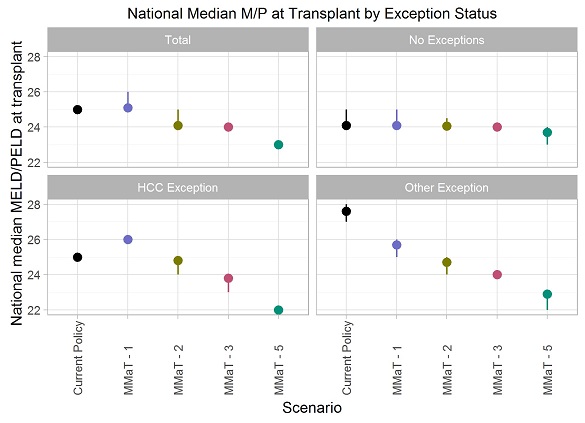MELD Exception Score: LSAM Modeling of a Fixed Floor.
1Mayo Clinic, Rochester
2UCSF, San Francisco
3SRTR, Minneapolis
4Univ of Minnesota, Minneapolis
5Stanford Univ, Stanford
Meeting: 2017 American Transplant Congress
Abstract number: 441
Keywords: Allocation, Liver
Session Information
Session Name: Concurrent Session: Liver Waitlist Outcome and Risk Stratification
Session Type: Concurrent Session
Date: Tuesday, May 2, 2017
Session Time: 2:30pm-4:00pm
 Presentation Time: 2:54pm-3:06pm
Presentation Time: 2:54pm-3:06pm
Location: E271a
Current US liver allocation policy grants standard MELD score exceptions beginning at 22 points and rising every 3 months. Scores for hepatocellular cancer are delayed for 6 months, then start at 28 and increase every 3 months until capped at 34. A steady rise in median MELD at transplant (MMaT) has been observed concurrent with increases in transplants for patients with MELD exceptions, and there is a disparity in waitlist outcomes and transplant rates for patients with and without exceptions. We hypothesized that an exception MELD score set at a fixed interval below MMaT rather than a continuously rising score may improve this disparity and potentially slow the rise in MMaT.
Using LSAM software and SRTR data from 2007-2011, we modeled the relative impact of policies including a fixed exception score at varying levels of MELD points below the listing DSA's MMaT. Results were compared with modeling of current exception score rules. MELD scores have been increasing over time, thus the absolute values of median MELD/PELD at transplant shown may not reflect those for current candidates; however, the overall pattern of change between scenarios should be similar.
Fixing the exception score at MMaT-3 and MMaT-5 increased transplant rates for MELD/PELD 29-34 candidates, and all alternative scoring systems increased the transplant rate for MELD ≥35 candidates. Transplant rates for exception candidates decreased commensurate with decreasing exception point assignment, although the rate for exception candidates remained higher than for non-exception candidates. National MMaT decreased as the awarded exception points in a scenario decreased. Posttransplant mortality was not projected to change.
Figure 1. National MMaT by Exception Status  Conclusions: A fixed floor rather than an elevator scoring model for MELD score exceptions may result in lower MMaT, and may improve the disparity in transplant rates between exception and non-exception candidates without affecting posttransplant mortality.
Conclusions: A fixed floor rather than an elevator scoring model for MELD score exceptions may result in lower MMaT, and may improve the disparity in transplant rates between exception and non-exception candidates without affecting posttransplant mortality.
CITATION INFORMATION: Heimbach J, Hirose R, Schladt D, Pyke J, Zeglin J, Leppke S, Lake J, Kim W. MELD Exception Score: LSAM Modeling of a Fixed Floor. Am J Transplant. 2017;17 (suppl 3).
To cite this abstract in AMA style:
Heimbach J, Hirose R, Schladt D, Pyke J, Zeglin J, Leppke S, Lake J, Kim W. MELD Exception Score: LSAM Modeling of a Fixed Floor. [abstract]. Am J Transplant. 2017; 17 (suppl 3). https://atcmeetingabstracts.com/abstract/meld-exception-score-lsam-modeling-of-a-fixed-floor/. Accessed December 13, 2025.« Back to 2017 American Transplant Congress
